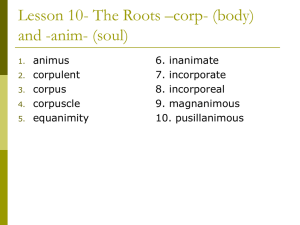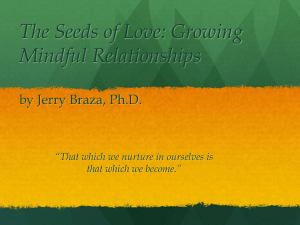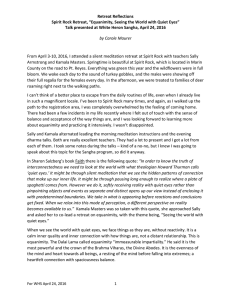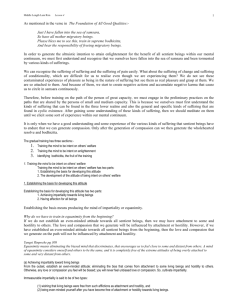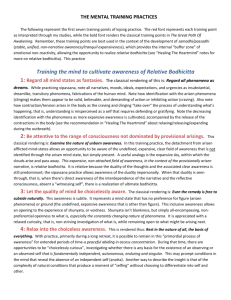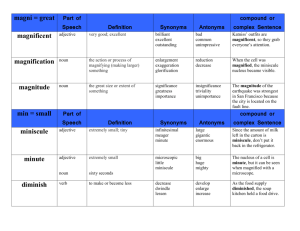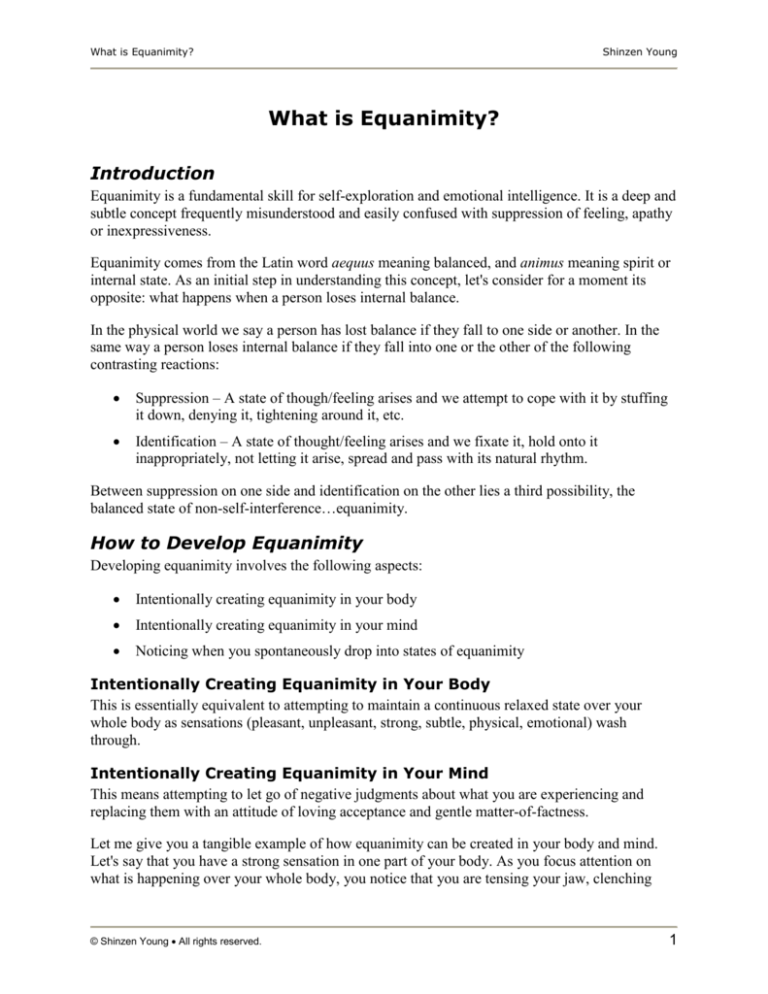
What is Equanimity?
Shinzen Young
What is Equanimity?
Introduction
Equanimity is a fundamental skill for self-exploration and emotional intelligence. It is a deep and
subtle concept frequently misunderstood and easily confused with suppression of feeling, apathy
or inexpressiveness.
Equanimity comes from the Latin word aequus meaning balanced, and animus meaning spirit or
internal state. As an initial step in understanding this concept, let's consider for a moment its
opposite: what happens when a person loses internal balance.
In the physical world we say a person has lost balance if they fall to one side or another. In the
same way a person loses internal balance if they fall into one or the other of the following
contrasting reactions:
Suppression –A state of though/feeling arises and we attempt to cope with it by stuffing
it down, denying it, tightening around it, etc.
Identification –A state of thought/feeling arises and we fixate it, hold onto it
inappropriately, not letting it arise, spread and pass with its natural rhythm.
Between suppression on one side and identification on the other lies a third possibility, the
balanced state of non-self-i
nt
e
r
f
e
r
e
nc
e
…e
qua
ni
mi
t
y
.
How to Develop Equanimity
Developing equanimity involves the following aspects:
Intentionally creating equanimity in your body
Intentionally creating equanimity in your mind
Noticing when you spontaneously drop into states of equanimity
Intentionally Creating Equanimity in Your Body
This is essentially equivalent to attempting to maintain a continuous relaxed state over your
whole body as sensations (pleasant, unpleasant, strong, subtle, physical, emotional) wash
through.
Intentionally Creating Equanimity in Your Mind
This means attempting to let go of negative judgments about what you are experiencing and
replacing them with an attitude of loving acceptance and gentle matter-of-factness.
Let me give you a tangible example of how equanimity can be created in your body and mind.
Let's say that you have a strong sensation in one part of your body. As you focus attention on
what is happening over your whole body, you notice that you are tensing your jaw, clenching
© Shinzen Young All rights reserved.
1
What is Equanimity?
Shinzen Young
your fists, tightening your gut, and squnching your shoulders. Each time you become aware of
tensing in some area, you intentionally relax it to whatever degree possible. A moment later you
may notice that the tensing has started again in some area; once again gently relax it to whatever
degree possible. If there are areas that cannot be relaxed much or at all, you try to accept the
tension sensations and just observe them.
As a result of maintaining this whole-body relaxed state, you may begin to notice subtle flavors
of sensation spreading from the local area of intensity and coursing through your body. These are
the sensations that you had been masking by tension. Now that they have been uncovered, try to
create a mental attitude of welcoming them, not judging them. Observe them with gentle matterof-factness, giving them permission to dance their dance, to flow as they wish through your
body.
Noticing When you Spontaneously Drop into States of Equanimity
From time to time, as we are passing through various experiences, we simply “
fall into”states of
relative equanimity. If we are alert to this whenever it happens and use it as an opportunity to
explore the nature of equanimity, then it will happen more frequently and last longer.
For example, let's say that you have been working with a physical discomfort. At some point you
notice that even though the discomfort level itself has not changed, it somehow seems to bother
you less. Upon investigation you realize that you have spontaneously fallen into a state of gentle
matter-of-factness. By being alert to this and by exploring the state, you are training your
subconscious to produce the state more frequently.
The Effects of Equanimity
Equanimity belies the adage that you cannot “
have your cake and eat it too.”When you apply
equanimity to unpleasant sensations, they flow more readily and as a result cause less suffering.
When you apply equanimity to pleasant sensations, they also flow more readily and as a result
deliver deeper fulfillment. The same skill positively affects both sides of the sensation picture.
Hence the following equation:
Psycho-spiritual Purification = (Pain x Equanimity) + (Pleasure x Equanimity)
Furthermore, when feelings are experienced with equanimity, they assure their proper function as
motivators and directors of behavior as opposed to driving and distorting behavior. Thus
equanimity plays a critical role in changing negative behaviors such as substance and alcohol
abuse, compulsive eating, anger, violence, and so forth.
Equanimity, Apathy and Suppression
Equanimity involves non-interference with the natural flow of subjective sensation. Apathy
implies indifference to the controllable outcome of objective events. Thus, although seemingly
similar, equanimity and apathy are actually opposites. Equanimity frees up internal energy for
responding to external situations. By definition, equanimity involves radical permission to feel
and as such is the opposite of suppression. As far as external expression of feeling is concerned,
internal equanimity gives one the freedom to externally express or not, depending on what is
© Shinzen Young All rights reserved.
2
What is Equanimity?
Shinzen Young
appropriate to the situation. (For a schematic chart of these relationships, see How Should a
Meditator Express Emotion?)
Passion and Dispassion
Passion is an ambiguous word with at least four meanings:
Deep perception of feeling
Unhindered expression of deep feeling
Dynamic behavior that rides on deep feeling
Suffering and behavior distortion caused by feeling that is experienced incompletely (that
is to say without sufficient equanimity)
Due to this ambiguity, one could validly claim that people become more passionate as they learn
to be dispassionate.
Physical Analogies for Equanimity
Developing equanimity is analogous to:
Reducing friction in a mechanical system (Equanimity =1/F)
Reducing viscosity in a hydrodynamic system (Equanimity =1/V)
Reducing resistance in a DC circuit (Equanimity =1/R)
Reducing impedance in an AC circuit (Equanimity =1/Z)
Reducing stiffness in a spring (Equanimity =1/K)
A solution being thixotropic as opposed to rheopectic
Extending these metaphors, perfect equanimity would be analogous to becoming a
superconductive super fluid.
Another Synonym for Equanimity
Love.
Equanimity in Christianity
Early and Medieval Christianity placed a great value on equanimity. Indeed it was considered
one of the primary Christian virtues. This is because Christianity viewed itself as a path of
radical spiritual cleansing (katharsis), with equanimity as the main tool for achieving this goal.
The church fathers, who wrote primarily in Greek, had three words for equanimity:
Nepsis: “
Sober observation”
Ataraxia: “
Freedom from upset”
Apathia: “
Dispassion”(N.B. Apathia does not equal apathy!)
© Shinzen Young All rights reserved.
3
What is Equanimity?
Shinzen Young
In Christianity, the theory of purification through equanimity constituted a major branch of
spiritual study known technically as “
ascetical theology.”
Equanimity in Judaism and Islam
The Hebrew word for equanimity is hashlamah, which is directly related to the word for peace
(shalom) and the word for completeness (shlemut). In a sense the entire spiritual path is
contained within the three Hebrew letters shin-lamed-mem (sh-l-m): When one is fully present
(shalem) and equanimous (hashlamah) with what is, then what is presents itself as God's peace
(shalom).
The term Islam is usually interpreted to mean the peace that comes with surrender. It is the
Arabic cognate of the Hebrew word hashlamah. A Muslim is literally “
one who has become
equanimous.”
© Shinzen Young All rights reserved.
4

